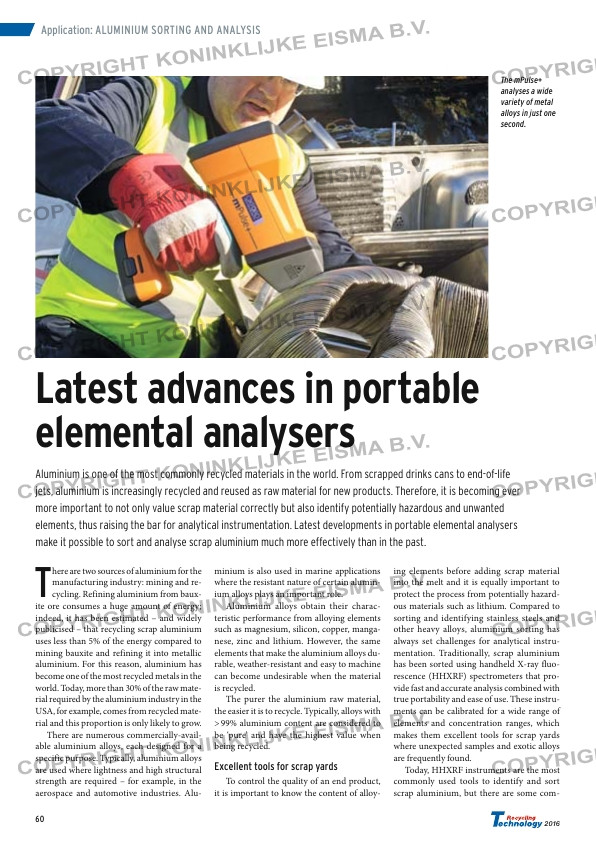Page 58 from: Recycling Technology 2016

60
2016
Latest advances in portable
elemental analysers
Aluminium is one of the most commonly recycled materials in the world. From scrapped drinks cans to end-of-life
jets, aluminium is increasingly recycled and reused as raw material for new products. Therefore, it is becoming ever
more important to not only value scrap material correctly but also identify potentially hazardous and unwanted
elements, thus raising the bar for analytical instrumentation. Latest developments in portable elemental analysers
make it possible to sort and analyse scrap aluminium much more effectively than in the past.
T
here are two sources of aluminium for the
manufacturing industry: mining and re-
cycling. Refining aluminium from baux-
ite ore consumes a huge amount of energy;
indeed, it has been estimated – and widely
publicised – that recycling scrap aluminium
uses less than 5% of the energy compared to
mining bauxite and refining it into metallic
aluminium. For this reason, aluminium has
become one of the most recycled metals in the
world. Today, more than 30% of the raw mate-
rial required by the aluminium industry in the
USA, for example, comes from recycled mate-
rial and this proportion is only likely to grow.
There are numerous commercially-avail-
able aluminium alloys, each designed for a
specific purpose. Typically, aluminium alloys
are used where lightness and high structural
strength are required – for example, in the
aerospace and automotive industries. Alu-
minium is also used in marine applications
where the resistant nature of certain alumin-
ium alloys plays an important role.
Aluminium alloys obtain their charac-
teristic performance from alloying elements
such as magnesium, silicon, copper, manga-
nese, zinc and lithium. However, the same
elements that make the aluminium alloys du-
rable, weather-resistant and easy to machine
can become undesirable when the material
is recycled.
The purer the aluminium raw material,
the easier it is to recycle. Typically, alloys with
> 99% aluminium content are considered to
be ‘pure’ and have the highest value when
being recycled.
Excellent tools for scrap yards
To control the quality of an end product,
it is important to know the content of alloy-
ing elements before adding scrap material
into the melt and it is equally important to
protect the process from potentially hazard-
ous materials such as lithium. Compared to
sorting and identifying stainless steels and
other heavy alloys, aluminium sorting has
always set challenges for analytical instru-
mentation. Traditionally, scrap aluminium
has been sorted using handheld X-ray fluo-
rescence (HHXRF) spectrometers that pro-
vide fast and accurate analysis combined with
true portability and ease of use. These instru-
ments can be calibrated for a wide range of
elements and concentration ranges, which
makes them excellent tools for scrap yards
where unexpected samples and exotic alloys
are frequently found.
Today, HHXRF instruments are the most
commonly used tools to identify and sort
scrap aluminium, but there are some com-
Application: ALUMINIUM SORTING AND ANALYSIS
The mPulse+
analyses a wide
variety of metal
alloys in just one
second.



